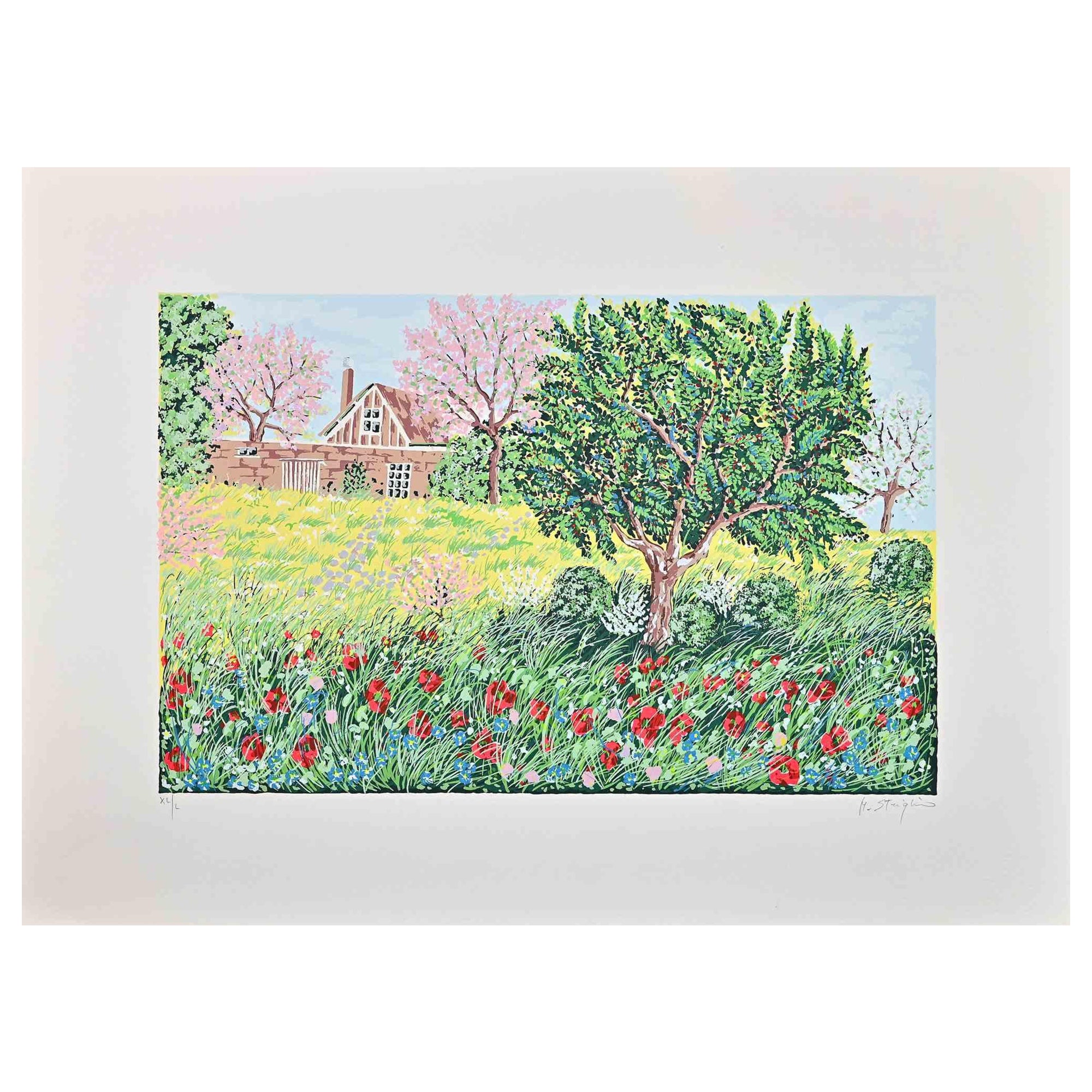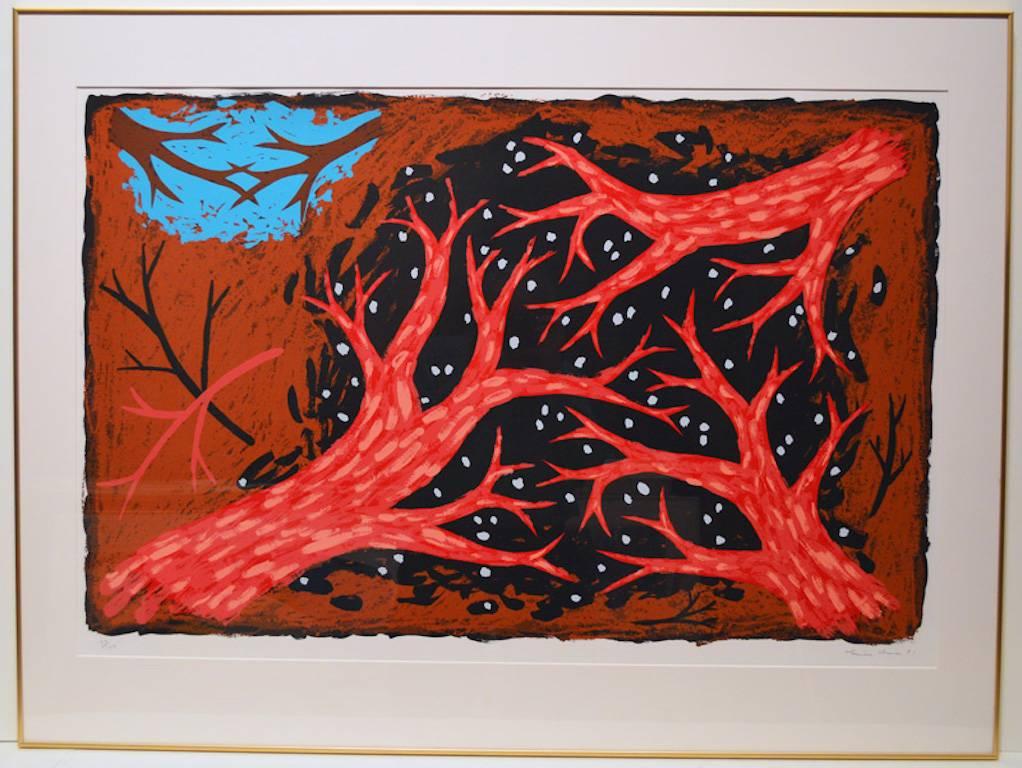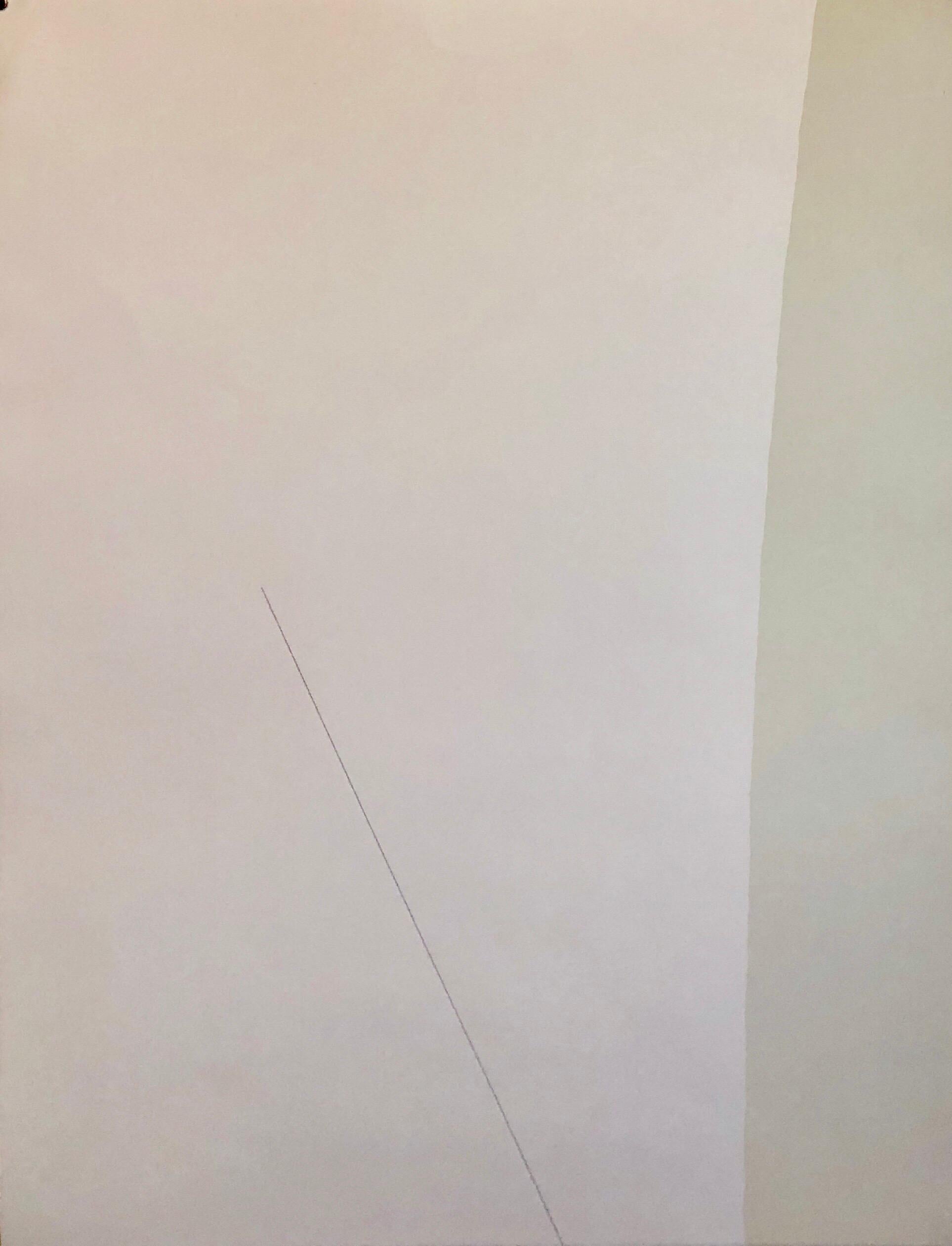Items Similar to Spring - Original Screen Print by Maddalena Striglio - Late 20th Century
Want more images or videos?
Request additional images or videos from the seller
1 of 7
Maddalena StriglioSpring - Original Screen Print by Maddalena Striglio - Late 20th CenturyLate 20th Century
Late 20th Century
About the Item
The Spring is a very brightly colored screen print realized by the contemporary Italian artist Maddalena Striglio in the late 20th Century.
Hand-signed in pencil on the lower left. Numbered on the lower right. Edition 44/150.
Good conditions.
Maddalena Striglio , a painter with particular lyrical sensitivity, sought light in the world of nature with her art. This beautiful print represents a colorful landscape with beautiful blossoming trees in a flowery green meadow.
- Creator:Maddalena Striglio
- Creation Year:Late 20th Century
- Dimensions:Height: 27.56 in (70 cm)Width: 39.38 in (100 cm)Depth: 0.04 in (1 mm)
- Medium:
- Movement & Style:
- Period:
- Framing:Framing Options Available
- Condition:Insurance may be requested by customers as additional service, contact us for more information.
- Gallery Location:Roma, IT
- Reference Number:
About the Seller
4.9
Platinum Seller
These expertly vetted sellers are 1stDibs' most experienced sellers and are rated highest by our customers.
1stDibs seller since 2017
6,808 sales on 1stDibs
Typical response time: 3 hours
- ShippingRetrieving quote...Ships From: Rome, Italy
- Return PolicyA return for this item may be initiated within 14 days of delivery.
More From This SellerView All
- Cityscape - Original Screen Print - 20th CenturyLocated in Roma, ITCityscape is an original screen print on Hand-made paper realized by an Anonymous artist of the 20th Century. The State of preservation is good. The artwork represents the citysca...Category
20th Century Modern Landscape Prints
MaterialsScreen
- My Retreat - Screen Print by Maddalena Striglio - Late 20th centuryLocated in Roma, ITMy Retreat is a very brightly colored screen print realized by the contemporary Italian artist Maddalena Striglio in the late 20th Century. Hand-s...Category
Late 20th Century Modern Landscape Prints
MaterialsScreen
- Explosive Spring - Original Screen print by Maddalena Striglio-Late 20th centuryLocated in Roma, ITExplosive Spring is a very brightly colored screen print realized by the contemporary Italian artist Maddalena Striglio in the late 20th Century. Hand-signed in pencil on the lower...Category
Late 20th Century Modern Figurative Prints
MaterialsScreen
- Landscape - Screen Print by Luca Dall'Olio - 2000sLocated in Roma, ITLandscape is an artwork realized by Luca Dall'Olio. Materic screen printing on canvas, cm 65x50, ex. IV/XXX. Signature and edition On the back: Stamperia d'Arte Artevalori stamp ...Category
Early 2000s Modern Figurative Prints
MaterialsPaper, Screen
- Roman Arch - Screen Print by Marco Orsi - 1980sLocated in Roma, ITRoman Arch (Arch of Constantine) is an original screen print on paper realized by the Italian artist Marco Orsi (1926 - 1999). Hand-signed on the lower rig...Category
1980s Modern Figurative Drawings and Watercolors
MaterialsScreen, Paper
- Navona Square - Screen Print by Carlo Mazzoni - Late 20th CenturyBy Carlo MazzoniLocated in Roma, ITNavona Square - Rome is an original serigraph realized by Carlo Mazzoni (1922). Hand-signed by the artist in pencil on the lower right corner. Numbered on the lower-left corner. Edi...Category
Late 20th Century Modern Figurative Prints
MaterialsScreen
You May Also Like
- New York Skyline at Night - Offset Poster, 2008By Andreas FeiningerLocated in Paris, FRAndreas FEININGER New York Skyline at Night, 2008 Offset original vintage poster On paper 68 x 74 cm (c. 27 x 29 in) Original poster for artist's exhibition in Fundation Juan March ...Category
Early 2000s American Modern Landscape Prints
MaterialsScreen
- Long BranchBy Brad DavisLocated in New York, NYBrad Davis has exhibited at The Museum of Modern Art in New York, the New Museum of Contemporary Art in new York, the Hudson River Museum, the Uni...Category
Late 20th Century Modern Landscape Prints
MaterialsScreen, Woodcut
- Red TreesBy Louisa ChaseLocated in New York, NYLouisa Chase was born in Panama City, Panama. Seven years later, her family moved to Lancaster, Pennsylvania. She studied painting and sculpture at Syracuse University and at the Yal...Category
Early 20th Century Modern Landscape Prints
MaterialsScreen
- Michael Gross Israeli Minimalist Conceptual Art, Abstract Jerusalem SilkscreenBy Michael GrossLocated in Surfside, FLMichael Gross (Hebrew: מיכאל גרוס; 1920 – 4 November 2004) was an Israeli painter, sculptor and conceptual artist. Michael Gross was born in Tiberias in the British-administered Palestine in 1920. He grew up in the farming village of Migdal. In 1939-1940, he left to study at the Teachers’ Training College in Jerusalem. In 1939, while he was away, his father was murdered by Arabs, and the family farm and home were destroyed. This event impacted on his work as an artist. From 1943 to 1945, he studied architecture at Technion – Israel Institute of Technology in Haifa. From 1951 to 1954, he studied art at the École nationale supérieure des Beaux-Arts in Paris. He returned to Israel in 1954 and settled in the artists’ village of Ein Hod. Gross's works are imbued with the light and spirit. They are minimalist, but never pure abstraction, always tied to natural form and laden with feeling. In his early paintings, Gross simplified form in order to concentrate on proportion, broad areas of color, and the size and placement of each element. This reductive process was also notable in his sculptures, whether in painted iron or other materials such as white concrete. In later paintings, he often juxtaposed large off-white panels with patches of tone, adding textured materials such as wooden beams, burlap and rope. Gross’s rough, freely-brushed surfaces, along with the use of soft pastel coloring, conjure up images of the Israeli landscape. Education 1936-1940 Teachers Seminary, Jerusalem 1943-1945, Technion, Haifa, architecture, studied sculpture with Moshe Ziffer. 1951-1954 Beaux Arts, Paris with Michel Guimond Teaching 1954 - 1954 Higher School of Education, Haifa. 1957-1960 Bezalel Academy of Arts and Design, Jerusalem 1960-1980 Oranim Art Institute, Tivon Awards 1964: Hermann Struck Prize 1967: Dizengoff Prize 1971...Category
1970s Modern Landscape Prints
MaterialsLithograph, Screen
- Modernist Silkscreen Screenprint 'El Station, Interior' NYC Subway, WPA ArtistBy Anthony VelonisLocated in Surfside, FLscreenprint printed in color ink on wove paper. New York City subway station interior. Anthony Velonis (1911 – 1997) was an American painter and designer born in New York City who helped introduce the public to silkscreen printing in the early 20th century. While employed under the federal Works Progress Administration, WPA during the Great Depression, Velonis brought the use of silkscreen printing as a fine art form, referred to as the "serigraph," into the mainstream. By his own request, he was not publicly credited for coining the term. He experimented and mastered techniques to print on a wide variety of materials, such as glass, plastics, and metal, thereby expanding the field. In the mid to late 20th century, the silkscreen technique became popular among other artists such as Robert Rauschenberg and Andy Warhol. Velonis was born into a relatively poor background of a Greek immigrant family and grew up in the tenements of New York City. Early on, he took creative inspiration from figures in his life such as his grandfather, an immigrant from the mountains in Greece, who was "an ecclesiastical painter, on Byzantine style." Velonis attended James Monroe High School in The Bronx, where he took on minor artistic roles such as the illustration of his high school yearbook. He eventually received a scholarship to the NYU College of Fine Arts, into which he was both surprised and ecstatic to have been admitted. Around this time he took to painting, watercolor, and sculpture, as well as various other art forms, hoping to find a niche that fit. He attended NYU until 1929, when the Great Depression started in the United States after the stock market crash. Around the year 1932, Velonis became interested in silk screen, together with fellow artist Fritz Brosius, and decided to investigate the practice. Working in his brother's sign shop, Velonis was able to master the silkscreen process. He reminisced in an interview three decades later that doing so was "plenty of fun," and that a lot of technology can be discovered through hard work, more so if it is worked on "little by little." Velonis was hired by Mayor LaGuardia in 1934 to promote the work of New York's city government via posters publicizing city projects. One such project required him to go on a commercial fishing trip to locations including New Bedford and Nantucket for a fortnight, where he primarily took photographs and notes, and made sketches. Afterward, for a period of roughly six months, he was occupied with creating paintings from these records. During this trip, Velonis developed true respect and affinity for the fishermen with whom he traveled, "the relatively uneducated person," in his words. Following this, Velonis began work with the Public Works of Art Project (PWAP), an offshoot of the Civil Works Administration (CWA), where he was assigned to serve the different city departments of New York. After the formation of the federal Works Progress Administration, which hired artists and sponsored projects in the arts, he also worked in theater. Velonis began working for the federal WPA in 1935. He kept this position until 1936 or 1938, at which point he began working in the graphic art division of the Federal Art Project, which he ultimately led. Under various elements of the WPA program, many young artists, writers and actors gained employment that helped them survive during the Depression, as well as contributing works that created an artistic legacy for the country. When interviewed in December 1994 by the Library of Congress about his time in the WPA, Velonis reflected that he had greatly enjoyed that period, saying that he liked the "excitement" and "meeting all the other artists with different points of view." He also said in a later interview that "the contact and the dialogue with all those artists and the work that took place was just invaluable." Among the young artists he hired was Edmond Casarella, who later developed an innovative technique using layered cardboard for woodcuts. Velonis introduced silkscreen printing to the Poster Division of the WPA. As he recalled in a 1965 interview: "I suggested that the Poster division would be a lot more productive and useful if they had an auxiliary screen printing project that worked along with them. And apparently this was very favorably received..." As a member of the Federal Art Project, a subdivision of the WPA, Velonis later approached the Public Use of Arts Committee (PUAC) for help in "propagandizing for art in the parks, in the subways, et cetera." Since the Federal Art Project could not be "self-promoting," an outside organization was required to advertise their art more extensively. During his employment with the Federal Art Project, Velonis created nine silkscreen posters for the federal government. Around 1937-1939 Velonis wrote a pamphlet titled "Technical Problems of the Artist: Technique of the Silkscreen Process," which was distributed to art centers run by the WPA around the country. It was considered very influential in encouraging artists to try this relatively inexpensive technique and stimulated printmaking across the country. In 1939, Velonis founded the Creative Printmakers Group, along with three others, including Hyman Warsager. They printed both their own works and those of other artists in their facility. This was considered the most important silkscreen shop of the period. The next year, Velonis founded the National Serigraph Society. It started out with relatively small commercial projects, such as "rather fancy" Christmas cards that were sold to many of the upscale Fifth Avenue shops...Category
1980s American Modern Figurative Prints
MaterialsScreen
- SUN GLOWBy Phil DikeLocated in Santa Monica, CAPHIL DIKE (1906 - 1990) SUN GLOW . 1960 Color serigraph, edition 25. Signed, numbered and tItled in pencil . Image 15 x 23 inches. Sheet 16 1/2 x 23 1/2 in...Category
1960s Modern Landscape Prints
MaterialsScreen
Recently Viewed
View AllMore Ways To Browse
Maddalena Striglio
Arabic Inscription
Braun Artist
California Woodcut
Window Guards
Ski Gold
Landscape Wood Block Print
Trees Woodcut Print
Lino Cut Prints
Impressionist Prints Lakes
Hiroshige Edo Prints
Holy Jerusalem
Pastoral Print
Lithograph Art Farm
Harbor Island Black And White
Hiroshige Woodcuts
Penna Art
Buffet Lithograph




